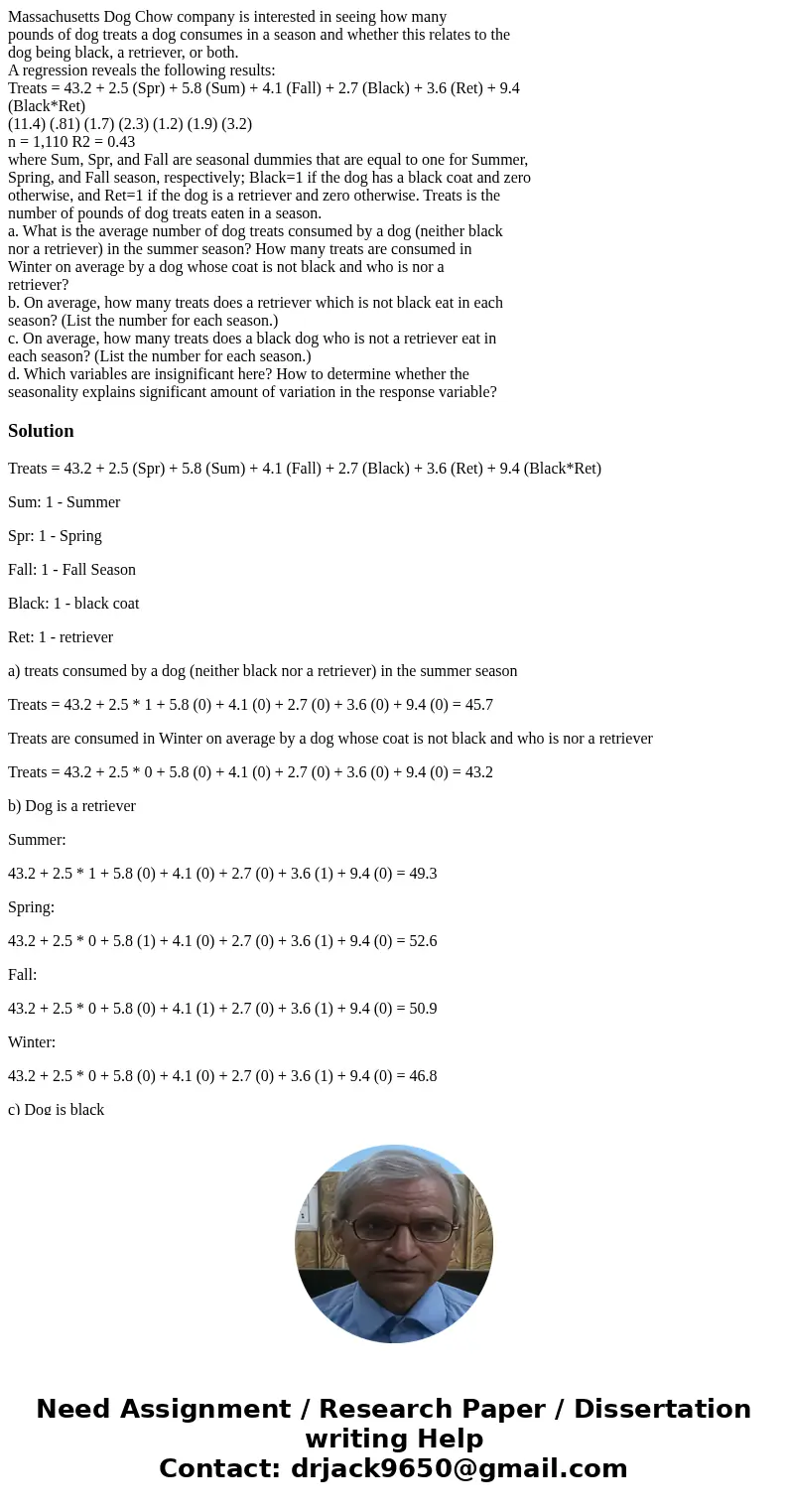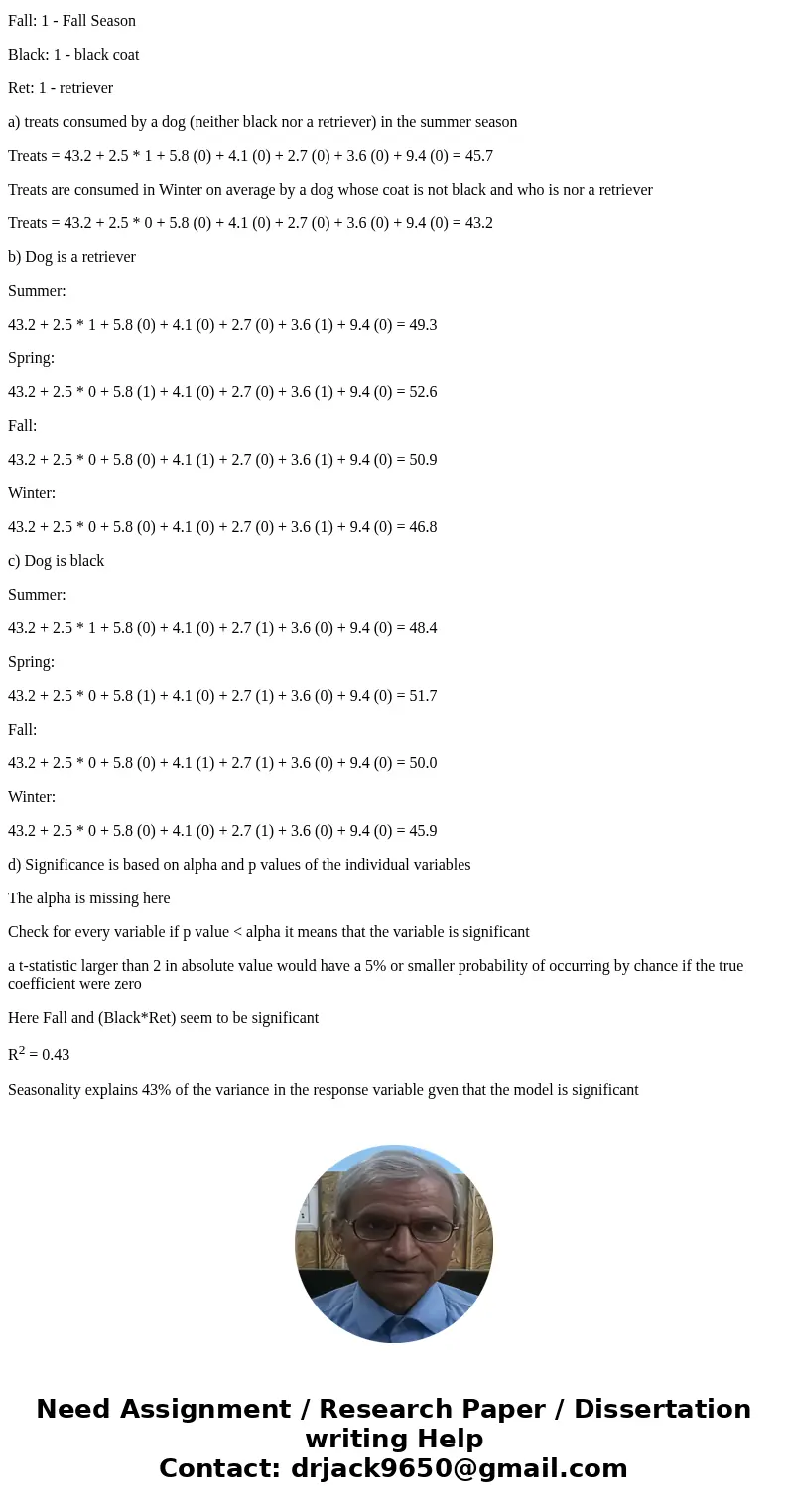Massachusetts Dog Chow company is interested in seeing how m
Massachusetts Dog Chow company is interested in seeing how many
pounds of dog treats a dog consumes in a season and whether this relates to the
dog being black, a retriever, or both.
A regression reveals the following results:
Treats = 43.2 + 2.5 (Spr) + 5.8 (Sum) + 4.1 (Fall) + 2.7 (Black) + 3.6 (Ret) + 9.4
(Black*Ret)
(11.4) (.81) (1.7) (2.3) (1.2) (1.9) (3.2)
n = 1,110 R2 = 0.43
where Sum, Spr, and Fall are seasonal dummies that are equal to one for Summer,
Spring, and Fall season, respectively; Black=1 if the dog has a black coat and zero
otherwise, and Ret=1 if the dog is a retriever and zero otherwise. Treats is the
number of pounds of dog treats eaten in a season.
a. What is the average number of dog treats consumed by a dog (neither black
nor a retriever) in the summer season? How many treats are consumed in
Winter on average by a dog whose coat is not black and who is nor a
retriever?
b. On average, how many treats does a retriever which is not black eat in each
season? (List the number for each season.)
c. On average, how many treats does a black dog who is not a retriever eat in
each season? (List the number for each season.)
d. Which variables are insignificant here? How to determine whether the
seasonality explains significant amount of variation in the response variable?
Solution
Treats = 43.2 + 2.5 (Spr) + 5.8 (Sum) + 4.1 (Fall) + 2.7 (Black) + 3.6 (Ret) + 9.4 (Black*Ret)
Sum: 1 - Summer
Spr: 1 - Spring
Fall: 1 - Fall Season
Black: 1 - black coat
Ret: 1 - retriever
a) treats consumed by a dog (neither black nor a retriever) in the summer season
Treats = 43.2 + 2.5 * 1 + 5.8 (0) + 4.1 (0) + 2.7 (0) + 3.6 (0) + 9.4 (0) = 45.7
Treats are consumed in Winter on average by a dog whose coat is not black and who is nor a retriever
Treats = 43.2 + 2.5 * 0 + 5.8 (0) + 4.1 (0) + 2.7 (0) + 3.6 (0) + 9.4 (0) = 43.2
b) Dog is a retriever
Summer:
43.2 + 2.5 * 1 + 5.8 (0) + 4.1 (0) + 2.7 (0) + 3.6 (1) + 9.4 (0) = 49.3
Spring:
43.2 + 2.5 * 0 + 5.8 (1) + 4.1 (0) + 2.7 (0) + 3.6 (1) + 9.4 (0) = 52.6
Fall:
43.2 + 2.5 * 0 + 5.8 (0) + 4.1 (1) + 2.7 (0) + 3.6 (1) + 9.4 (0) = 50.9
Winter:
43.2 + 2.5 * 0 + 5.8 (0) + 4.1 (0) + 2.7 (0) + 3.6 (1) + 9.4 (0) = 46.8
c) Dog is black
Summer:
43.2 + 2.5 * 1 + 5.8 (0) + 4.1 (0) + 2.7 (1) + 3.6 (0) + 9.4 (0) = 48.4
Spring:
43.2 + 2.5 * 0 + 5.8 (1) + 4.1 (0) + 2.7 (1) + 3.6 (0) + 9.4 (0) = 51.7
Fall:
43.2 + 2.5 * 0 + 5.8 (0) + 4.1 (1) + 2.7 (1) + 3.6 (0) + 9.4 (0) = 50.0
Winter:
43.2 + 2.5 * 0 + 5.8 (0) + 4.1 (0) + 2.7 (1) + 3.6 (0) + 9.4 (0) = 45.9
d) Significance is based on alpha and p values of the individual variables
The alpha is missing here
Check for every variable if p value < alpha it means that the variable is significant
a t-statistic larger than 2 in absolute value would have a 5% or smaller probability of occurring by chance if the true coefficient were zero
Here Fall and (Black*Ret) seem to be significant
R2 = 0.43
Seasonality explains 43% of the variance in the response variable gven that the model is significant


 Homework Sourse
Homework Sourse